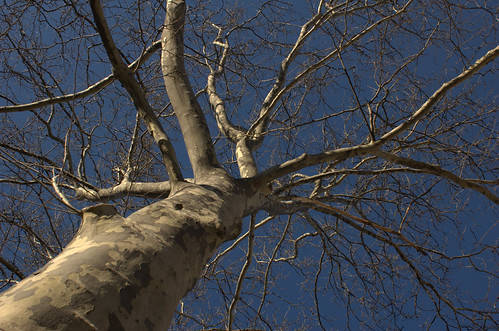Welcome, Apartment Therapy readers! If this story interests you, be sure to learn more by checking out the related posts linked at the end of this article.
Barbara Corcoran thinks the owner of this “townhouse” [sic] should chop down this maple tree, pave over the front yard, and park cars there instead to increase their property values.

Queens Crap has the goods on this (Daily News columnist advocates paving). I learned about it through Brooklyn Junction (Barbara Corcoran Weighs In On Proposed Yard Change), who was alerted to it by commenter “dbs” on his post about the Yards Text Amendment. I’ve read some excellent follow-up by my neighbor, Crazy Stable (Get a cement truck over there fast) and Forgotten New York (Cuckoo Corcoran).
Trees increase the selling prices of residential properties. Paving over the front yard will decrease the resale value of a home. It will also incur other annual costs to the homeowner, such as energy costs.
As a realtor (not just any realtor, “New York’s top realtor” the byline for her column asserts), Corcoran should know better. She should at least know better than to advise her readers out of ignorance. But then, it’s her Manhattan-myopic company that, even after years of doing business in Brooklyn and the other “outer” boroughs, has no category for “house” in their listings. And ascribes the name “Ditmas Park” to most of Victorian Flatbush. Not to mention she should know something about the Department of City Planning.
Barbara Corcoran thinks this is a townhouse.

Oh, and as soon as possible they should chop down that pesky Cherry tree and pave over the front yard so they can park cars on it. She’s sure it will increase the property value.
Q. My wife and I have lived in Queens for the past 10 years and we plan on staying in the area for about another five. We are noticing lately that all of our neighbors are paving their yards and then use the space to park their cars on.
My wife has spent many hours cultivating her plants and would like to keep the garden, but I think having a driveway will help us increase the price of the house when it comes time to sell. What do you think?
A. Hey, a flower garden might look pretty and keep your wife happy, but the space in front of your house is worth a hell of a lot more as a driveway. [emphasis added]
You should know that the city council of Queens [sic, it’s the DCP proposal, the Yards Text Amendment] has just proposed a zoning change that would prohibit residents from paving their yards in some areas.
So get your wife on your side and get a cement truck over there fast.
– Ask Barbara, New York Daily News, November 8, 2007
What do you think? Leave a comment below. Even better, write Barbara herself.
[goo.gl]
Related Posts
Factoid: Street Trees and Property Values, December 2
The State of the Forest in New York City, November 12
Preserving Livable Streets: DCP’s Yards Text Amendment, November 6
Victorian Flatbush at risk from inappropriate zoning, October 23
Another reason to loathe real estate brokers, April 6
NASA Earth Observatory Maps NYC’s Heat Island, Block by Block, August 1, 2006
Links
Daily News columnist advocates paving, Queens Crap
Barbara Corcoran Weighs In On Proposed Yard Change, Brooklyn Junction
Yards Text Amendment, Brooklyn Junction
Get a cement truck over there fast, Crazy Stable
Cuckoo Corcoran, Forgotten New York
Footnotes
If you email Barbara Corcoran, you’ll get this robo-response:
Thanks for sending a question to “Ask Barbara”. Look for Barbara’s answer to your question in her “Ask Barbara” column appearing every Friday in Your Home only in the Daily News. Look for more real estate questions and Barbara’s helpful answers at www.nydailynews.com.
Would you like to speak to Barbara directly? Simply reply to this message with your full name, town and daytime phone number. You may be invited to ask your question on Barbara’s new show!
The title of this post comes from the Dilbert comic of June 19. Dogbert has been hired as a green-washing consultant for the company. He advises the pointy-haired boss, “Stop eating, breathing, driving, defecating, and procreating. Sit in the dark and decompose on some garden seeds. Or do you admit you hate the Earth?” The boss responds, “A little.” The cartoon was taken up by anti-environmental bloggers such as Moonbattery: “Thank you Dilbert, for attempting to rescue us from militant kooks who think the global warming hoax is real.”
This is not Barbara Corcoran







